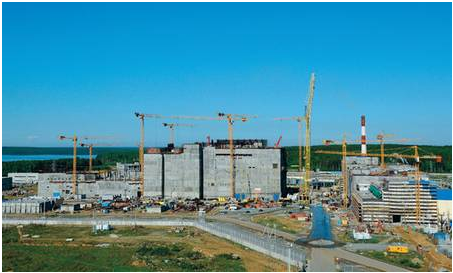My recent posts have been about breeder reactors which generate more fissile material than they consume. There is renewed global interest in breeder reactors for the production of nuclear fuel and the destruction of nuclear waste. Today's post is the third in a series about the history and current status of breeder reactors in the Soviet Union and Russia.
At the U.N. Millennium General Conference in 2000, Russian President Putin revealed his intentions to expand the fleet of Russian nuclear reactors. Although light water reactors were the primary focus, work on fast breeder reactors was also part of the new program. The first stage of the fast breeder project was going to be the construction of a few reactors based on the BN-800 design. There were four goals for the fast breeder project:
"1. Develop a closed uranium-plutonium fuel cycle;
2. Produce chain-reacting uranium-233 from neutron capture in thorium
blankets as a potential fuel for thermal-neutron reactors;
3. Fission the minor transuranics, neptunium, americium and curium; and,
4. Significantly reduce highly radioactive waste volume for a final geological
repository."
In 2005, the Russian Duma received a proposal for the construction of ten fast breeder reactors to create fuel to replace diminishing uranium reserves in Russia.
A lot of experiments were performed in Russia over the years to test fast breeder reactor design. Safety was a primary concern. After much work on the sodium cooling system, it was decided that the addition a secondary cooling loop was necessary. This made the cost of construction of the BN-600 about fifty percent more than a conventional light water reactor. The cost estimations for the BN-800 were around two and a half billion dollars which is about ten percent higher than the cost of a light water reactor. The cost of electricity generated by the BN-800 will be much greater than the cost of electricity generated by the light water reactors. Construction of the first BN-800 reactor started in 2006 but had continuing problems with funding. It was originally intended to replace the BN-600 which is slated to be shut off permanently in 2020. The BN-800 is still under construction with operation slated to begin in 2015.
In 2010, the head of Russian state company Rosatom suggested an international cooperation program for fast breeder technology. "I would like to propose that the states concerned launch an international program of multilateral cooperation in the research and development of fast-breeder reactors, including safety concerns. Plans were outlined for a multifunctional fast breeder research reactor for "broad cooperation, both on a multilateral and bilateral basis" which could be built by 2017.
In 2012, the BN-1200 fast breeder reactor was approved for construction at Beloyarsk. It will be based on the BN-800 design and it will replace the BN-600. Also in 2012, the Chinese contracted to buy two BN-800 units from the Russian company Rosatom. They are to be built in the city of Sanming in Fujian Province.
Russia currently plans to construct eight fast breeder reactors and an advanced fuel reprocessing facility. This will allow Russia to become a source of fuel for the world's nuclear reactors as the world's production of uranium declines. While this will be beneficial for Russia it may not be so beneficial for the rest of the world. Russia has already reduced gas and oil supplies to European countries during international disputes. If Russia becomes the source of nuclear fuel for the world, it might decide to punish other countries by cutting off supplies of nuclear fuel.
BN-800 reactor construction:
